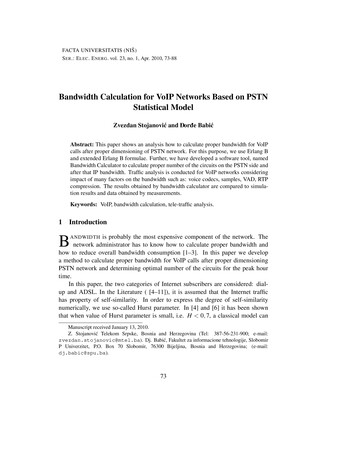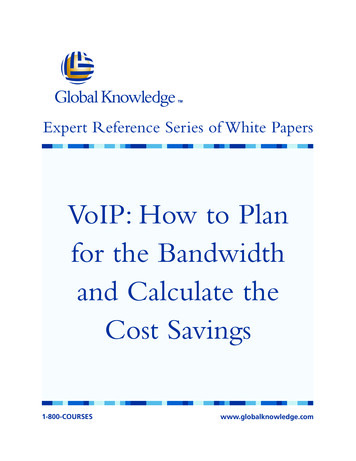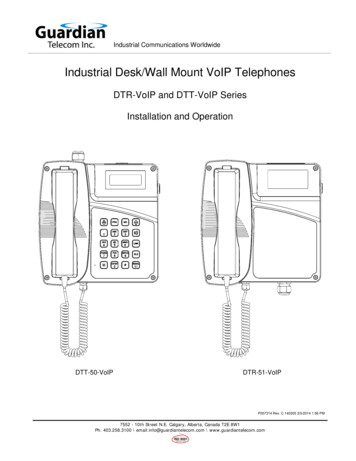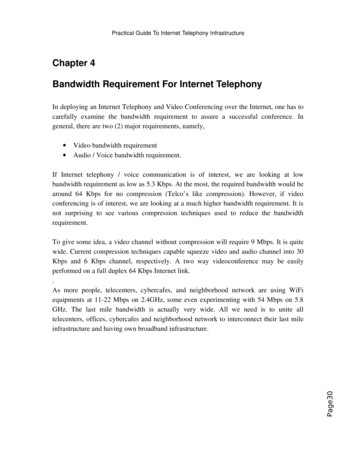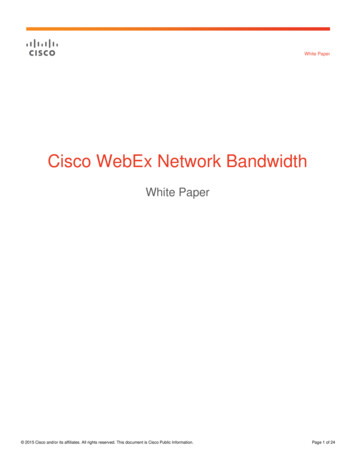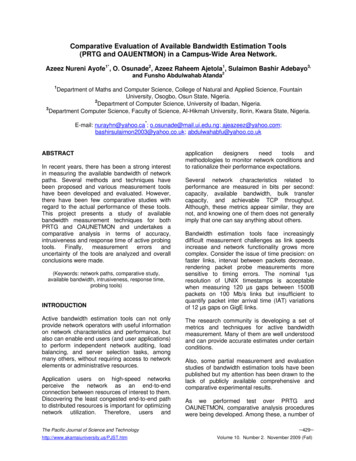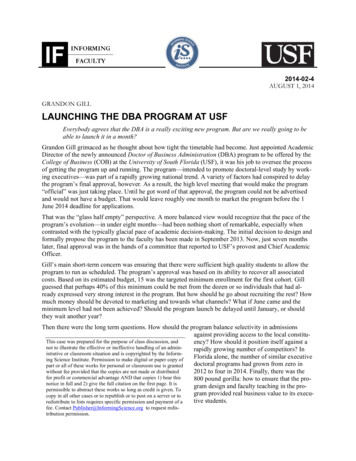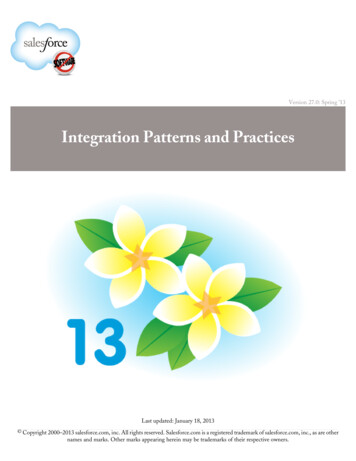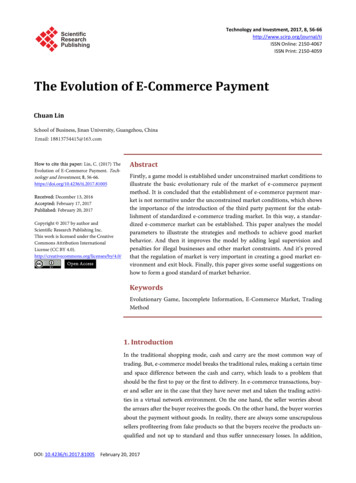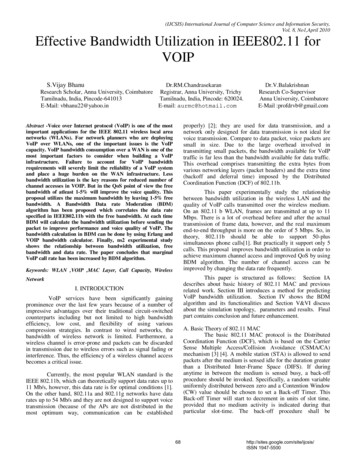
Transcription
(IJCSIS) International Journal of Computer Science and Information Security,Vol. 8, No1,April 2010Effective Bandwidth Utilization in IEEE802.11 forVOIPS.Vijay BhanuDr.RM.ChandrasekaranResearch Scholar, Anna University, Coimbatore Registrar, Anna University, TrichyTamilnadu, India, Pincode-641013Tamilnadu, India, Pincode: 620024.E-Mail: vbhanu22@yahoo.inE-mail: aurmc@hotmail.comDr.V.BalakrishnanResearch Co-SupervisorAnna University, CoimbatoreE-Mail :profdrvb@gmail.comproperly) [2]; they are used for data transmission, and anetwork only designed for data transmission is not ideal forvoice transmission. Compare to data packet, voice packets aresmall in size. Due to the large overhead involved intransmitting small packets, the bandwidth available for VoIPtraffic is far less than the bandwidth available for data traffic.This overhead comprises transmitting the extra bytes fromvarious networking layers (packet headers) and the extra time(backoff and deferral time) imposed by the DistributedCoordination Function (DCF) of 802.11b.Abstract -Voice over Internet protocol (VoIP) is one of the mostimportant applications for the IEEE 802.11 wireless local areanetworks (WLANs). For network planners who are deployingVoIP over WLANs, one of the important issues is the VoIPcapacity. VoIP bandwidth consumption over a WAN is one of themost important factors to consider when building a VoIPinfrastructure. Failure to account for VoIP bandwidthrequirements will severely limit the reliability of a VoIP systemand place a huge burden on the WAN infrastructure. Lessbandwidth utilization is the key reasons for reduced number ofchannel accesses in VOIP. But in the QoS point of view the freebandwidth of atleast 1-5% will improve the voice quality. Thisproposal utilizes the maximum bandwidth by leaving 1-5% freebandwidth. A Bandwidth Data rate Moderation (BDM)algorithm has been proposed which correlates the data ratespecified in IEEE802.11b with the free bandwidth. At each timeBDM will calculate the bandwidth utilization before sending thepacket to improve performance and voice quality of VoIP. Thebandwidth calculation in BDM can be done by using Erlang andVOIP bandwidth calculator. Finally, ns2 experimental studyshows the relationship between bandwidth utilization, freebandwidth and data rate. The paper concludes that marginalVoIP call rate has been increased by BDM algorithm.This paper experimentally study the relationshipbetween bandwidth utilization in the wireless LAN and thequality of VoIP calls transmitted over the wireless medium.On an 802.11 b WLAN, frames are transmitted at up to 11Mbps. There is a lot of overhead before and after the actualtransmission of frame data, however, and the real maximumend-to-end throughput is more on the order of 5 Mbps. So, intheory, 802.11b should be able to support 50-plussimultaneous phone calls[1]. But practically it support only 5calls. This proposal improves bandwidth utilization in order toachieve maximum channel access and improved QoS by usingBDM algorithm. The number of channel access can beimproved by changing the data rate frequently.Keywords: WLAN ,VOIP ,MAC Layer, Call Capacity, WirelessThis paper is structured as follows: Section IAdescribes about basic history of 802.11 MAC and previousrelated work. Section III introduces a method for predictingVoIP bandwidth utilization. Section IV shows the BDMalgorithm and its functionalities and Section V&VI discussabout the simulation topology, parameters and results. Finalpart contains conclusion and future enhancement.NetworkI. INTRODUCTIONVoIP services have been significantly gainingprominence over the last few years because of a number ofimpressive advantages over their traditional circuit-switchedcounterparts including but not limited to high bandwidthefficiency, low cost, and flexibility of using variouscompression strategies. In contrast to wired networks, thebandwidth of wireless network is limited. Furthermore, awireless channel is error-prone and packets can be discardedin transmission due to wireless errors such as signal fading orinterference. Thus, the efficiency of a wireless channel accessbecomes a critical issue.A. Basic Theory of 802.11 MACThe basic 802.11 MAC protocol is the DistributedCoordination Function (DCF), which is based on the CarrierSense Multiple Access/Collision Avoidance (CSMA/CA)mechanism [3] [4]. A mobile station (STA) is allowed to sendpackets after the medium is sensed idle for the duration greaterthan a Distributed Inter-Frame Space (DIFS). If duringanytime in between the medium is sensed busy, a back-offprocedure should be invoked. Specifically, a random variableuniformly distributed between zero and a Contention Window(CW) value should be chosen to set a Back-off Timer. ThisBack-off Timer will start to decrement in units of slot time,provided that no medium activity is indicated during thatparticular slot-time. The back-off procedure shall beCurrently, the most popular WLAN standard is theIEEE 802.11b, which can theoretically support data rates up to11 Mb/s, however, this data rate is for optimal conditions [1].On the other hand, 802.11a and 802.11g networks have datarates up to 54 Mb/s and they are not designed to support voicetransmission (because of the APs are not distributed in themost optimum way, communication can be SSN 1947-5500
(IJCSIS) International Journal of Computer Science and Information Security,Vol. 8, No1,April 2010plain IEEE802.11 MAC protocol, and adopting an additionalapplication aware module, logically placed above the MAClayer. In reference [9] proposes two feedback-based bandwidthallocation algorithms exploiting HCCA to provide servicewith guaranteed bounded delays: (1) the Feedback BasedDynamic Scheduler (FBDS) and (2) the Proportional Integral(PI)-FBDS. They have been designed using classic discretetime feedback control theory. We will assume that bothalgorithms, running at the HC, allocate the WLAN channelbandwidth to wireless stations hosting real-time applications,using HCCA functionalities. This allows the HC to assignTXOPs (transmission opportunity) to ACs by taking intoaccount their specific time constraints and transmission queuelevels. We will refer to a WLAN system made of an AccessPoint and a set of quality of service enabled mobile stations(QSTAs). Each QSTA has up to 4 queues, one for each AC inthe 802.11e proposal. FBDS require a high computationaloverhead at the beginning of each service period, due to thequeue length estimation.suspended anytime the medium is determined to be busy andwill be resumed after the medium is determined to be idle foranother DIFS period. The STA is allowed to start transmissionas soon as the Back-off Timer reaches zero. A mobile station(STA) shall wait for an ACK when a frame is sent out. If theACK is not successfully received within a specific ACKtimeout period, the STA shall invoke back-off andretransmission procedure. The CW value shall be increasedexponentially from a CWmin value until up to a CWmax valueduring each retransmission.An additional Request to Send/ Clear To Send(RTS/CTS) mechanism is defined to solve a hidden terminalproblem inherent in Wireless LAN. The successful theexchange of RTS/CTS ensures that channel has been reservedfor the transmission from the particular sender to the particularreceiver. The use of RTS/CTS is more helpful when the actualdata size is larger compared with the size of RTS/CTS. Whenthe data size is comparable with the size of RTS/CTS, theoverhead caused by the RTS/CTS would compromise theoverall performance.By [8] Wireless Timed Token Protocol (WTTP)provides traffic streams with a minimum reserved rate, asrequired by the standard, and it accounts for two types oftraffic streams simultaneously, depending on thecorresponding application: constant bit rate, which are servedaccording to their rate, and variable bit rate traffic streams.Additionally, WTTP shares the capacity which is not reservedfor QoS traffic streams transmissions among traffic flows withno specific QoS requirements. This VAD [10] algorithm iscapable of removing white noise as well as frequency selectivenose and maintaining a good quality of speech.II. PREVIOUS WORKSThis section, reviews the existing literature related toenhancing voip call capacity. In reference [5] Aggregationwith fragment Retransmission (AFR) scheme, multiplepackets are aggregated into and transmitted in a single largeframe. If errors happen during the transmission, only thecorrupted fragments of the large frame are retransmitted.Clearly, new data and ACK frame formats are a primaryconcern in developing a practical AFR scheme. Optimal frameand fragment sizes are calculated using this model, and analgorithm for dividing packets into near-optimal fragments isdesigned. Difficulties for new formats include 1) respectingthe constraints on overhead noted previously and 2) ensuringthat, in an erroneous transmission, the receiver is able toretrieve the correctly transmitted fragments—this is notstraightforward because the sizes of the corrupted fragmentsmay be unknown to the receiver.III. CALCULATING BANDWIDTH CONSUMPTION FORVOIPBandwidth is defined as the ability to transfer data(such as a VoIP telephone call) from one point to another in afixed amount of time.The bandwidth needed for VoIPtransmission will depends on a few factors: the compressiontechnology, packet overhead, network protocol used andwhether silence suppression is used. Voice streams are firstencapsulated into RTP packets, and they are carried byUDP/IP protocol stack [3]. A single voice call consists of twoopposite RTP/UDP flows. One is originated from the AP to awireless station, and the other oppositely flows. There are twoprimary strategies for improving IP network performance forvoice: several techniques were proposed for QoS provisioningin wireless networks[11] [12]. Allocate more VoIP bandwidthand implement QoS.Extended dual queue scheme (EDQ) provides a QoSfor the VoIP service enhancement over 802.11 WLAN. Itproposes a simple software upgrade based solution, called anExtended Dual queue Scheme (EDQ), to provide QoS to realtime services such as VoIP [6]. The extended dual queuescheme operates on top of the legacy MAC. The dual queueapproach is to implement two queues, called VoIP queue anddata queue. Especially, these queues are implemented abovethe 802.11 MAC controllers, i.e., in the device driver of the802.11 network interface card (NIC), such that a packetscheduling can be performed in the driver level. Packets fromthe higher layer or from the wire line port (in case of the AP)are classified to transmit into VoIP or data types. Packets inthe queues are served by a simple strict priority queuing sothat the data queue is never served as long as the VoIP queueis not empty. But the hardware upgrade is undesirable.How much bandwidth to allocate depends on:The cross-layer scheme of [7] [8] is named asVertical Aggregation (VA) since it works along the same flow.The main advantage is that it enhances voice capacity using a69 Packet size for voice (10 to 320 bytes of digitalvoice) CODEC and compression technique (G.711, G.729,G.723.1, G.722, proprietary) Header compression (RTP UDP IP), which isoptionalhttp://sites.google.com/site/ijcsis/ISSN 1947-5500
(IJCSIS) International Journal of Computer Science and Information Security,Vol. 8, No1,April 2010 Layer 2 protocols, such as point-to-point protocol(PPP), Frame Relay and Ethernet Silence suppression / voice activity detectionIV. PROPOSED ALGORITHMThe main reason for the extra bandwidth usage is IPand UDP headers. VoIP sends small packets and so manytimes, the headers are actually much larger than the data partof the packet. The proposed algorithm based on the followingtwo factors. 1) A small frame is in error then there is a highprobability of error for a large frame as well. Similarly when alarge frame is successful, there is a very high probability ofsuccess for small frames as well. 2) The amount of freebandwidth decreases as the number of VoIP calls increases. Aswell as the call quality decreases as the number of VoIP callsincreases. Free Bandwidth (BWfree) that corresponds to theremaining unused idle time that can be viewed as spare oravailable capacity. In BDM algorithm, at each frametransmission will calculates the free bandwidth availability.Calculating the bandwidth for a VoIP call is notdifficult once you know the method and the factors to include.The chart below, "Calculating one-way voice bandwidth,"demonstrates the overhead calculation for 20 and 40 bytecompressed voice (G.729) being transmitted over a FrameRelay WAN connection [13]. Twenty bytes of G.729compressed voice is equal to 20 ms of a word.Voice digitization and compression:G .711: 64,000 bps or 8000 bytes per secondVariablesG.729: 8000 bps or 1000 bytes per secondBWfree: Unused idle bandwidth viewed as spare or availablecapacityBWload: Specifies the bandwidth used for transmission of thedata framesDrate: It specifies the data rateIncr: Increment operationDecr: Decrement operationProtocol packet overhead:IP 20 bytes, UDP 8 bytes, RTP 12 bytesTotal:40 bytesIf one packet carries the voice samples representing20 milliseconds, the 50 such samples are required to betransmitted in every second.Each sample carries anIP/UDP/RTP header overhead of 320 bits [14]. Therefore, ineach second, 16,000 header bits are sent. As a general rule of‘thumb’, it can be assumed that header information will add16kbps to the bandwidth requirement for voice over IP. Forexample, if an 8kbps algorithm such as G.729 is used, the totalbandwidth required to transmit each voice channel would be24kbps.Functions:UpperLevel (): upper level according to table 1, 2LowerLevel (): lower level according to the table 1, 2A. BDM ALGORITHM:Initial level:Drate: LowerLevel ()BWfree: UpperLevel ()S: Previous transmissionIf (S Success){Incr Drate to next UpperLevel ()Decr BWfree to next LowerLevel ()}Else{Decr Drate to next LowerLevel ()Incr BWfree to next UpperLevel ()}According to IEEE 802.11b only four types of datarates are available, which are 1, 2, 5.5, 11mbps. When the datarate is high then the throughput increases at the same time thechance for occurring error also increases [1] [15]. To avoidthis situation BDM allocates some free bandwidth to improvethe QoS. This free bandwidth allocation should be at theminimum level otherwise again quality degradation occurs.The voice transmission requirements are, Bandwidth requirements reduced with compression,G.711, G.729 etc. Bandwidth requirements reduced whenpackets are used, thereby reducing overhead. Even though the voice compression is an 8 to 1 ratio,the bandwidth reduction is about 3 or 4 to 1. Theoverhead negates some of the voice compressionbandwidth savings. Compressing the RTP, UDP and IP headers is mostvaluable when the packet also carries compressedvoice.longerA. Packet OverheadTo support voice over WLANs, it is important toreduce the overhead and improve the transmission efficiencyover the radio link. Recently, various header compressiontechniques for VoIP have been proposed [14]. TheRTP/UDP/IP headers can be compressed to as small as 2bytes.TABLE1: LEVELS OF DATA RATELevelsLevel 0Level 1Level 2Level 370Data Rate1 mbps2 mbps5.5 mbps11 mbpshttp://sites.google.com/site/ijcsis/ISSN 1947-5500
(IJCSIS) International Journal of Computer Science and Information Security,Vol. 8, No1,April 2010TABLE2: LEVELS OF BANDWIDTH FREELevels% of Free BandwidthLevel 0Level 1Level 2Level 3Level 412345TABLE 3: PARAMETERS USED FOR SIMULATIONNumber of calls Correc Fac ( RB-RBT ) / CodecWhere,Correc Fac: Correction factor of real network performanceRB: Real bandwidth usageRBT: Real bandwidth used for data transmissionCodec: Bandwidth used by the codec to establish a callEnd-to-end (phone-to-phone) delay needs to belimited. The shorter the packet creation delay, the morenetwork delay the VoIP call can tolerate. Shorter packetscause less of a problem if the packet is lost. Short packetsrequire more bandwidth, however, because of increased packetoverhead (this is discussed below). Longer packets thatcontain more speech bytes reduce the bandwidth requirementsbut produce a longer construction delay and are harder to fix iflost. By BDM the data rate and free bandwidth will improvethe number of VOIP calls as well as performance.ParameterValueDIFS50 µsecSIFS10 µsecSlot time20 µsecCWmin32CWmax1023Data RateBasic rate1,2,5.5,11 Mbps1 MbpsPHY header192 µsecMAC header34 bytesACK248 µsecTABLE4: DATA RATES AND DISTANCE FOR VOIPV. SIMULATION TOPOLOGYData rate in Mbps544836241811The simulation study is conducted using the ns-2simulator. The simulation result will be compared with IEEE802.11 specifications. Any node can communicate with anyother node through base station. The number of stations can bevaried from 5 to 50. Wireless LAN networks are set up toprovide wireless connectivity within a finite coverage area of20 to 30m. The network simulator will be used to form anappropriate network topology under the Media Access Control(MAC) layer of the IEEE 802.11b. According to the IEEE802.11b protocol specifications [16], the parameters for theWLAN are shown in Table 3. When calculating bandwidth,one can't assume that every channel is used all the time.Normal conversation includes a lot of silence, which oftenmeans no packets are sent at all. So even if one voice call setsup two 64 Kbit RTP streams over UDP over IP over Ethernet(which adds overhead), the full bandwidth is not used at alltimes.Based on [2] the data rate and coverage area will be changed.802.11b standard can cover up to 82 meters of distance,considering that only the first 48 meters are usable for voice,the other 34 meters are not usable, therefore cellular area mustbe fit only to the 48 meters from the AP in order to avoidinterferences, which is depicted in table 4.Distance in meters0-2727-2929-3030-4242-540 - 48Fig 1: Free bandwidth analysis71http://sites.google.com/site/ijcsis/ISSN 1947-5500
(IJCSIS) International Journal of Computer Science and Information Security,Vol. 8, No1,April 2010Free bandwidth Total bandwidth-bandwidth utilized 100-87.5 13.5In this sample calculation the free bandwidth is13.5%. From this 8.5% of bandwidth can be utilized for frametransmission to achieve maximum throughput and leave 5% toobtain Qos. Fig 1 shows the difference between bandwidthutilization and free bandwidth. When the amount of freebandwidth dropped below 1% call quality becameunacceptable for all ongoing calls. The amount of freebandwidth is a good indicator for predicting VoIP call quality,but in the throughput point of view it should be reduced. Thiscontradiction can be solved by using BDM algorithm.VI. SIMULATION RESULTSFig 3: Variations in packet loss when number of framesincreasesA. ThroughputC. DelayThe throughput (measured in bps) corresponds to theamount of data in bits that is transmitted over the channel perunit time. In the following Fig 2 X-axis specifies timeslot andY-axis specifies the throughput. Consider for each time slotthe channel receives 10 frames. When the time slot is 4ms, thethroughput is 4200kbps, when it increases into 8ms it is7000kbps. The graph shows the gradual improvement and theoverall throughput is increased upto 87.5%.Investigating our third metric, average access delayfor high priority traffic, Fig 4 shows that has very low delaysin most cases, even though the delays increases when the loadgets very high. However, all the schemes have acceptabledelays [6], even though EDCA in most cases incur a longerdelay than the other schemes. Even if a scheme can give lowaverage access delay to high priority traffic, there might stillbe many packets that get rather high delays. With the numberof data stations increasing, the delay performance of the voicestations degrades. This tells that the VoIP performance issensitive to the data traffic.In fig-4 graph X-a
VOIP bandwidth calculator. Finally, ns2 experimental study shows the relationship between bandwidth utilization, free bandwidth and data rate. The paper conclu
